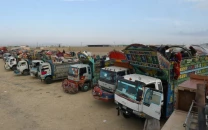35% of population comes under middle class
PIDE study uses multiple criteria, says Pakistan’s middle class is growing.

35% of population comes under middle class
The study, conducted by the Pakistan Institute of Development Economics (PIDE), finds that the size of the middle class in the country is 61 million people. The study also concludes, based on multiple criteria, that contrary to popular belief, Pakistan’s middle class, by virtue of sheer numbers is growing.
The study uses multiple criteria against the traditional criterion of income-based middle class. It focuses on factors like education, occupation, income, lifestyle and housing to determine the size of the middle class.
Understandably the middle class is found to be more of an urban phenomenon with its size being much larger in urban areas at both national and provincial levels. The study notes strong association between professional occupations and upper-middle and upper classes.
This fits in well with the general belief that professional occupations constitute the upper-middle class. Other white-collar occupations are taken up by the middle class, and manual occupations come under lower classes.
In her research paper titled “Estimating the size of the middle class in Pakistan”, Dr Durr-e-Nayab, Chief of Research and Head Department of Population Sciences, argues that the ‘middle class’ should not be confused with middle income.
Looking at provincial differences in the size of the middle class, Punjab has 37 per cent middle class followed by Sindh 36 per cent, Khyber-Pakhtunkhwa 32 per cent and Balochistan 29 per cent.
Interesting trends, however, are observed in rural and urban areas. Among urban areas, Sindh has the largest proportion of the middle class at 56 per cent followed by Punjab 55 per cent, Balochistan 50 per cent and Khyber-Pakhtunkhwa 49 per cent.
Punjab’s rural areas have the largest middle class at 24 per cent followed by Khyber-Pakhtunkhwa 22 per cent, Sindh and Balochistan 17 per cent each.
The PIDE study stresses the need for a comparative study in the region using the proposed multidimensional approach to gauge the actual size of the middle class. However, using existing definitions, when compared to its neighbours, barring Sri Lanka, Pakistan has a bigger share in middle class than all other countries including India.
In absolute terms, the Indian middle class is bigger in numbers given its much larger population size but it comprises a smaller proportion in terms of percentage. Hence, harnessing the gains that are associated with a big middle class are potentially available to the country.
The study concludes by quoting from an interesting analogy on the middle class in Pakistan by Burke (2010), who says “In Pakistan, the hierarchy on the roads reflects that of society. If you are poor, you use the overcrowded buses or a bicycle.
Small shopkeepers, rural teachers and better-off farmers are likely to have a $1,500 Chinese or Japanese motorbike…. Then come Mehran drivers. A rank above them, in air-conditioned Toyota Corolla saloons, is small businessmen, smaller landlords, more senior army officers and bureaucrats.
“Finally, there are the luxury four-wheel drives of ‘feudal’ landlords, big businessmen, expats, drug dealers, generals, ministers and elite bureaucrats. The latter may be superior in status, power and wealth, but it is the Mehrans which, by dint of numbers, dominate the roads.”
Published in The Express Tribune, October 27th, 2011.



















COMMENTS
Comments are moderated and generally will be posted if they are on-topic and not abusive.
For more information, please see our Comments FAQ